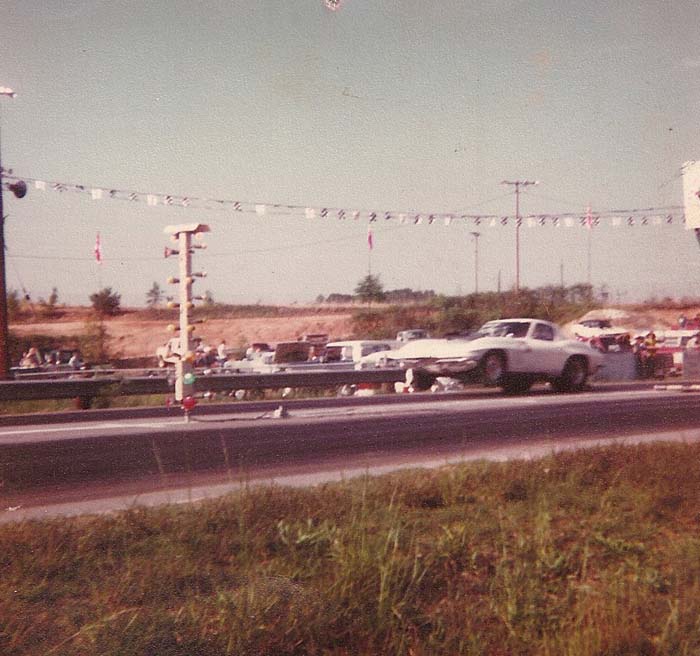ENCORE: BOBBY BENNETT: IT USED TO BE MY PLAYGROUND

Originally published December 2009
Tales of a kid and a closed down drag strip …
The fences still remain, as do dilapidated buildings, a reminder that a larger than life drag strip occupied the land.
To the drag racing community, Spartanburg Dragway was just another drag strip that fell victim to a new neighborhood where the neighbors created a community around the strip and then realized that drag strips are loud.
Spartanburg Dragway wasn’t purchased for a real estate investment. It was purchased to be silenced.
The abandoned parcel of land was the Promised Land, almost 30 years ago, for many dreams, including my own.
Ten years ago, as the editor of CompetitionPlus.com, I visited the remains of the once-proud drag strip. Defying the no trespassing signs, I recently visited it again.
There wasn’t a section of the drag strip pit area that I walked through that didn’t evoke memories of the epicenter of my childhood dream.
When you’re introduced to drag racing as a child and it hooks you, there’s an innocence that you maintain. Your local drag strip becomes the place where dreams came true.
Even if the place is a dump by others’ standards, you hold it in high esteem.

Spartanburg Dragway wasn’t a spectacular facility in its latter years of existence.
The pits weren’t paved and what pavement there was on the return roads and entry passages, had cracks and a few potholes in the latter years.
The racing surface left a lot to be desired and the safety aspects of the track’s configuration provided even less enthusiasm.
Those shortcomings didn’t affect my feelings about the facility in the least. It was drag racing as I knew it back then.
Spartanburg Dragway was built in 1963 by Paul Clayton Sr., and was located in the southern end of the small town in Spartanburg, SC. It was built across the street from a pay-to-swim public lake/beach, another sign of the times.
The legends all came there to race, Butch Leal, Hubert Platt, Ronnie Sox, Roy Hill and even a round of the Don Garlits versus Shirley “Cha Cha” Muldowney match race rivalry.
Maybe I saw the place through rose colored glasses as a kid who’d never experienced the politics of the sport. I lived a mile from the strip and on a good Saturday night, I could hear a small-block Modified Production wind up and go through the gear box. That was the lure that drew me towards the place.

And, when the opportunity arose to see for myself, the experience was exactly as I envisioned.
The smell of the burning rubber and sweet fragrance of VHT was like cookies baking at my grandmother’s house.
To hear in person, Bob Earnheart’s high-winding 1967 Corvette Stingray (IHRA Formula 2 E/Modified Production) was a symphony to my pre-teen ears.
Watching that car run was like a fourth grader watching the attractive six grade girl walking down the hall.
I was mesmerized by every car that ran down the track regardless of class.
When the sun went down and the lights turned on, the two story Spartanburg Dragway control tower bore a striking resemblance, at least in my eyes, to a fully illuminated Orange County International Raceway. You just had to see that glass tower at Spartanburg lit up on a summer night.
If you have any kind of imagination you could have seen it too.
You just had to be there to see Gene Fulton blow the rear-end out of a borrowed D/Modified Production on a Saturday night and vow like General Douglas MacArthur that he’d be back. The next weekend he brought the same class car and whipped the bracket racers all the way to the winner’s circle.
 You had to be there to see up-and-coming drag racers the likes of Tommy Mauney, Charles Carpenter, Michael Martin and Blake Wiggins, all of whom are considered Pro Modified pioneers, to know that one day that Spartanburg Dragway was a springboard to vibrant professional drag racing careers.
You had to be there to see up-and-coming drag racers the likes of Tommy Mauney, Charles Carpenter, Michael Martin and Blake Wiggins, all of whom are considered Pro Modified pioneers, to know that one day that Spartanburg Dragway was a springboard to vibrant professional drag racing careers.
You had to see, young Scott Duggins watching in admiration of his dad’s Super Pro Vega being piloted by a teenager named Quain Stott. Who would have ever thunk that Stott would become a professional world champion and that second-generation Duggins would win three sportsman championships?
Who would have ever believed the regular Saturday night fraternity from Spartanburg Dragway would account for over 30 world championships.
I did. That’s why, as a kid I wrote about those drivers and peddled a handwritten magazine to the racers. I saw something special in those racers and they saw something special in me.
We all saw something special at the track.
In my mind, my years in drag racing tell me this wasn’t a super track to get all worked up over.
My heart tells me otherwise.
My heart tells me this was the greatest drag strip ever built.
It used to be my playground. Even today, I can go back to that playground, at least in my mind.




















































